
[Download PowerPoint presentation (pdf))]
[Download handout]

- I begin my presentation this afternoon with a picture of the title page of Female Life Among the Mormons. The Welsh translation of several chapters of this anti-Mormon novel were printed in serial form in 1855 in Yr Amserau (The Times), a Welsh-language newspaper published in the town of Denbigh, North Wales.

- This drew an immediate response from Dan Jones,

- the editor of Udgorn Seion (Zion’s Trumpet), the Mormon periodical then in its 9th year of publication in South Wales. Dan Jones, back in Wales on his second mission, devoted a total of sixteen pages in two issues of his periodical to an article he entitled “‘The Times’ With Its Carcass in Its Mouth” and declares the novel to be a ‘dirty bag’ and the ‘filthiest’ of all the anti-Mormon literature he has ever read. He compares its many lies about Mormonism to a dead carcass and declared his surprise when he

- “saw that the Editor of the Times [whom he portrays as a bird of prey] had taken hold of the carcass with his teeth, sucking the sap, maggots and all down to his greedy gut almost to the point of bursting his stomach.” Here is what it sounds like in Welsh: “. . . hyd nes gweled Golygydd yr Amserau wedi cydio yn yr ysgerbwd a’i ddannedd, ac yn sugno ei sugn, cynrhon a’r cyfan i lawr i’w gylla gwancus hyd braidd dorri ei fola.”
- Further on in the article Jones wrote: “The Editor of the ‘Times’ proves himself totally unfit to edit any publication, and unworthy of the trust of the public by lowering himself with this shameless stream of lies. . . ”
- Jones also reprimanded Mr. Lloyd: “Every Editor should understand what is true and what is not true better than to lift up some disgusting posy like this (referring to the novel Female Life Among the Mormons) to the wind to ‘move away the disgrace that Mormonism has brought on the nation of the Welsh!’ . . . That would be the same thing as for the chimney sweep to attempt to clear away the soot from off the face of the sun.”
- Then Jones proposes a remedy for the editor: “We believe that the best way to cleanse the dirty things from the stomach of the “Times” would be to give it a dose of these pills (in reference to the clarifications Jones gives in his response) once in a while until the purging and the puking ”

- Dan Jones is well known in Mormon history as the Captain of the

- steamboat – the Maid of Iowa – who was with Joseph Smith in Carthage Jail and who received Joseph’s last recorded prophecy that Jones would live and yet serve the mission to Wales to which he had been called.

- President Gordon B. Hinckley wrote in 1993: “In terms of the number of converts, Dan Jones must certainly be included in the half dozen or so most productive missionaries in the history of the Church.”

- Dan Jones is sometimes confused with Daniel W. Jones, the young man who assisted in the rescue of the handcart companies in 1856. Dan Jones, 20 years older than Daniel W., crossed the plains that same year but was with Franklin D. Richards and others in the carriage that arrived in Salt Lake City with the alarming news that the handcart companies needed to be rescued.

- In the 36 hours following the Martyrdom, Jones had three narrow escapes from death and was thus able to fulfill Joseph’s prophecy. In fact he ended up serving two 4-year missions to Wales, but until recently relatively few details have surfaced about these missions that would shed light on the way he became such a productive missionary. My objective this afternoon is to remedy, at least to some extent, this dearth of information.

- My sources are as follows:
- Dan Jones’s journal – this is a wishful source and would be a treasure of information if I could find it – I know he kept one or possibly several, but I have yet to locate it.
- 26 of his letters to his file leaders in Liverpool during his two missions were printed in the Millennial Star – these have a fair amount of information.
- 20 of his handwritten letters mainly to Brigham Young, but also some to Wilford Woodruff, George A. Smith, and Thomas Bullock are preserved in the Church History Library – these have also been a valuable resource.
- A few letters written by admirers of Dan Jones, the missionary, have helped to round out his profile.
- Scores of articles published in the various Welsh-language religious periodicals provide what his opponents viewed as the negative aspects of Dan Jones and especially the evil of Mormonism. I will eventually provide English translations of all these articles on my website. To access this website just do a Google search for Welsh Mormon history – it will be the second item to appear.
- Of greatest importance are the published writings of Dan Jones in defense of Mormonism – his numerous pamphlets and the periodical that he established in July 1846, the first non-English-language periodical of the LDS Church. His energetic response to Mr. Lloyd, the editor of Yr Amserau (The Times), which I reviewed in my opening remarks is but a small taste of Dan Jones, the polemicist.
- He was the editor of the Welsh Mormon periodical for just under five years – a total of 1,728 pages. He published 37 pamphlets – a total of 554 pages. And he published a 288-page scriptural commentary. In all – 2,570 pages.

- The opposition Dan Jones faced
- Sermons were given regularly from the pulpits of the Nonconformist chapels – “nonconformist” religions were neither Catholic nor the Church of England in Wales.
- The vicars of the Church of England preached against the Mormons and used their periodical Yr Haul (The Sun) to print a substantial number of anti-Mormon articles
- Numerous anti-Mormon articles appeared in a variety of the Nonconformist periodicals – especially the two Baptist publications.
- The refusal of the editors of the periodicals to print any of Dan Jones’s rebuttals.
- Many episodes of disturbance of meetings held in the homes of members and in pubs – rock throwing, name calling, interruptions and shouting, arrests
- A few episodes of physical aggression and many threats – Dan Jones had to have round-the-clock protection for several days as he prepared to leave Merthyr Tydfil to take over 300 Welsh converts to America in 1849.
- David Jeremy, a convert from Carmarthenshire, was beaten so badly by a mob that only the intervention from a very brave onlooker saved his life.
- Dan Jones declared in an 1847 letter to Orson Spencer, “I delight in the trophies of war. I came here to fight for the spiritual freedom of my brethren, and I thank heaven, and the God of this warfare, that He is knocking off their shackles by hundreds!” (He could later say “by thousands.”
- A few weeks later he wrote: “If Brother Spencer wishes to know ‘the secret power of Welsh over English preaching,’ here it is! We fight hard for all we get, and contend toe to toe, and point to point, for every inch of ground we gain. . . My lips keep moisture and my lungs never tire, but just as ready now as ever, and my colors are firmly nailed to the masthead, and will sink or swim on the deck of my Mormon barque.”

- Many of you will recognize this Painting by Clark Kelly Price – this was commissioned by the Sons of the Utah Pioneers in 1993 and now hangs in the Provo MTC. It is also on page 1 of Preach My Gospel. I believe that the artist has captured an accurate image of Dan Jones, and certainly one that is consistent with the personality traits I have discovered about him in his writings and the writings of others about him – fearlessly and aggressively defending his belief in the restored gospel of Jesus Christ.

- This is William Howells – he is no doubt the greatest admirer of Dan Jones, whom he called his “adored father” in the gospel.

- In a letter to Orson Spencer, William Howells tells of his conversion to Mormonism – “Having spent twenty years nearly with the Baptist denomination seeking truth, but still in darkness, until the reply of dear Brother Jones to the false accusations of a neighboring Baptist minister, vindicating the principles of the Saints, came to my hand, which in a few hours proved the religion I professed to be no other than a sandy foundation—all my false hopes fled—all human traditions that I had cleaved to appeared folly. I was convinced that the Saints were the only true church of God.”

- Here are a few facts and figures about William Howells:
- Lay Baptist minister in Aberdare – about 4 miles from Merthyr Tydfil.
- Converted by a Dan Jones pamphlet
- Baptized the same night he met Dan
- Baptized 100 in one year – friends, family, former parishioners
- First Mormon missionary to France
- Baptized 50 people on the Olympus
- Early death – died at age 35 in 1851

- WH – reflections about Dan Jones – His sublime, generous, diligent spirit, applied itself with new exertion continually, as circumstances and experience opened an enlarged field for duty.

- WH – even more reflections about Dan Jones
- His clear head, good heart, solid sense, and serious piety
- His mind, calm and dispassionate
- Remarkable for aptness
- Disposing his principles with clear method, solid arguments, adorned with words well chosen
- [His] affection and humility on one hand, his resolution and courage on the other
- [Caused] the numerous religious sects of Wales . . . [to join together] in a covenant of everlasting peace. [Before the advent of Mormonism in Wales the various religious sects were fighting each other. But as many of their parishioners converted to Mormonism the sects banded together to fight the common enemy.]

- These reflections are from a lengthy letter by William Howells that was published in the Millennial Star – Here you can see the first page and a half

- And here you can see the final page. Throughout the entire letter he uses only superlatives in his assessment of Dan Jones.

- Now, by way of contrast, let us consider how the Reverend Edward Roberts, one of Dan Jones’s greatest detractors, viewed him – the Rev. Roberts gave numerous anti-Mormon lectures in the Merthyr Tydfil are in 1847 and 1848.

- Here you see Caersalem Chapel – a Baptist chapel located in Dowlais about two miles from Merthyr Tydfil – this was the scene of the Rev. Roberts’s 1st lecture against Mormonism.

- Here is a brief review of the lecture as viewed by a fellow Baptist: “Although it lasted for a few minutes under two hours, all the listeners stayed attentive till the end, showing their approval in endless cheers while the speaker continued. A better meeting was never had in Dowlais.”

- Dan Jones attended the lecture and had a slightly different assessment – “I seated myself in front, and took notes of his topics, and were you to see the fingers and eyes that evidently marked me as a gone case, you would have thought that I had seven horns, if not as many heads, and every time that the harlequin would strike the pulpit with his paw, and cry ‘Down with Mormonism!’ &c., in the midst of the echo of cheers, I had time and opportunity to inspect nearly all eyes in the place.” The Rev. Roberts spoke with great “hwyl” – a Welsh word meaning “religious fervor and enthusiasm” – and he threatened to “kill Mormonism and bury it by Christmas” – he did not specify which Christmas, however.

- And here you see the title page of DJ’s printed response – a 40-page pamphlet in which Dan Jones dissects and analizes each of the points that Roberts had tried to make – reading this pamphlet is what caused William Howells to convert. You will notice that the English translation has been typeset to match the format – as much as possible – of the original. I have used this procedure for the nearly 6,000 pages of Welsh Mormon writings I have thus far translated from Welsh to English. And for want of a better term I have called my procedure “facsimile translation.”

- Here is a brief quote From the preface of DJ’s pamphlet that reveals his feelings about the opposition and persecution he faced in Wales during the eight years of his two missions: “The blasphemies and unfounded claims of Mr. Roberts . . . are better for the spread of Mormonism than the stillness to be found in some other places; and while persecution and shame, although falling on myself and my brothers, are a means of spreading the truth in my dear country—welcome persecution! welcome pain! welcome shame!” This is the exultant spirit that kept Dan Jones going for eight years as a missionary.

- In his lecture the Rev. Roberts criticized Joseph Smith for having big hands “which signified that he lived well”. – Dan Jones responded: “You workers of Dowlais, remember to hide your hands in your pockets, or somewhere out of sight of this reverend, or he will condemn you also as cheats as bad as ‘Joe Smith!’”

- To round out Dan Jones the missionary here is some basic information about him:
- 1810 – born in North Wales in the small village of Halkyn
- One of 8 children of Thomas and Ruth Jones
- His father was a “blaenor” or an “elder” with the Methodists
- Probably worked in the lead mines as a child
- Went to sea at age 17 – sailed the 7 seas for over a decade
- He came to America with wife Jane in about 1840
- Built a steamboat “The Maid of Iowa”
- Baptized in the Mississippi River on the 19th of January, 1843

- The only words I have found that Dan Jones wrote about his childhood are those stimulated by a visit to his boyhood playground in 1855. He wrote them as part of an editorial in Zion’s Trumpet.– “Our mind ran back thirty years, when on these very roads there spritely played a ten-year-old lad. . . Angels of heaven around him would come; he perceived the light of the gospel, throng-like he would gather the children of the town to the surrounding fields to instruct them in faith, repentance, ‘baptism for forgiveness,’ and the ‘gifts of the Holy Ghost’ as promised; he would be persecuted by all for this, and so he wandered across the seas, islands and continents of the world seeking brethren of the same belief, whom for his comfort, an angel had promised him.” This quest for the truth and the promise of an angel that came to him at a very young age would explain Jones’s elation at finding the true religion at age 32 and his rock solid allegiance to it until his death 19 years later.

- And it was while operating the Maid of Iowa up and down the Mississippi River that Captain Dan Jones came to the knowledge of the restored gospel.

- In his 102-page History of the Latter-day Saints Jones provides some details of his conversion to Mormonism. He tells his own conversion story beginning on page 59. I have no idea how Dan Jones found the time to publish this 102-page history of the Church while on his first mission. Copies of the English translation of this History are available at the FairMormon book store.

- He wrote: “We should thank this Sharp [the editor of the Warsaw Signal] for the information we got about the Saints; for it was by reading his and others’ accusations that our attention was drawn to them before we saw them.”

- Once Dan Jones seriously investigated the doctrine of Mormonism he decided to get baptized.
- He was baptized on the 19th of January 1843 in the Mississippi River.
- About 3 months later he took about 200 English converts to Nauvoo where he first met Joseph Smith – there is a common misconception in Church history that Dan Jones was so impressed with Joseph Smith that he converted. The truth is that he was already a member of the Church at this first meeting.
- And when they first shook hands Joseph said, “God help this little man.” Despite the height difference – probably 6 to 8 inches – the two immediately bonded.
- A month later Dan Jones was called on a mission to his native Wales.
- The next day Joseph purchased half interest in the Maid of Iowa from Levi Moffat, Dan’s business partner. The idea was that Joseph would soon purchase Dan’s half so that Dan could be off on his mission.
- But it wouldn’t be until after the Martyrdom over a year later that Captain Jones would leave on his mission.

- Two weeks before the Martyrdom Joseph told Dan:
- “I have a check in the house for $1200 – as soon as I can get it cashed you shall have $1100 of it, and the start for Wales, not with your fingers in your mouth but prepared to buy a Press; and do business aright.”
- A decade later Dan wrote to Thomas Bullock: “Joseph never paid me the first dollar for the boat.”
- Fortunately, Dan Jones was philosophical about not receiving the money: “Thrilled with prospects of my Mission I left all, rejoicing in the exchange of a Steam Boat for an Eldership on the deck of the never sinking ship of life.” This reaction certainly adds an important dimension to the character of Dan Jones and as to how he structured his priorities in life.
- The phrase “to buy a press” is significant, as it indicates how DJ planned to proselytize in Wales

- Joseph Smith said to Dan Jones in Carthage: “You will see Wales and fulfill the mission appointed you ere you die.”

- A few weeks after the Martyrdom Jones started off to Wales on his mission
- Dan’s wife Jane accompanied him to Wales – they had no children as they had buried two and maybe three children in Nauvoo.
- Traveling with them were Wilford Woodruff and his wife.
- They made their way to New York, and on 7 Dec 1844 they left on the packet John B. Skiddy.
- Certainly along the way the seasoned missionary Wilford Woodruff must have talked about his great success at Benbow Farm with the United Brethren.
- And certainly Dan Jones was inspired by Wilford’s achievements probably making plans to do something similar in Wales.

- Dan Jones wrote a letter to Wilford Woodruff dated 24 February 1845.
- This was just 8 weeks after getting off the ship at Liverpool
- DJ was assigned to North Wales where he and his wife had family
- His “glad tidings” were not well received by family, friends, or former ministers
- He sounds disappointed in his report – “I have neglected writing until now, expecting to have the better news to give you, because I had some forebodings of glorious consequences.”

- On 6 April 1845 Dan Jones spoke at a conference in Manchester
- This was just 7 weeks after his letter to Wilford Woodruff
- Dan Jones’s address made a huge impression on the scribe
- The scribe wrote that Jones was ill; he had no baptisms to report; he spoke of Wales, a nation renowned in history
- Quote: “He enlarged on the characteristics of his people in a manner, and with an eloquence, that told how ardently he loved his native tribe and his fatherland.”
- The scribe continued: He told of his search for truth and how he had gained a testimony of Joseph Smith.
- Also: “He would not flinch from bearing a faithful testimony to the character of [Joseph Smith].”
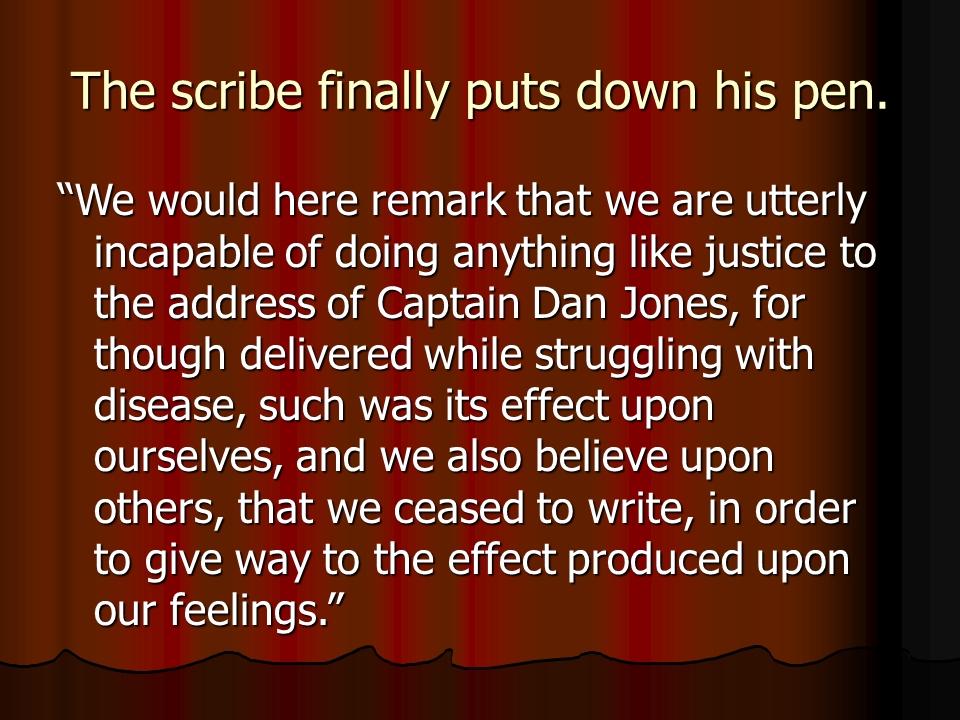
- The scribe finally puts down his pen after writing
- “We would here remark that we are utterly incapable of doing anything like justice to the address of Captain Dan Jones, for though delivered while struggling with disease, such was its effect upon ourselves, and we also believe upon others, that we ceased to write, in order to give way to the effect produced upon our feelings.” And now we have at least some idea as to the effect that Dan Jones’s oratorical skills had on others.

- Here you see the Title page of DJ’s 1st pamphlet in Welsh – side-by-side with the English translation. My guess is that he was hoping to have this published before the Manchester Conference so he could take copies with him – at least then he would have something to show for his first three months as a missionary.

- Here are a few details of DJ’s 1st pamphlet in Welsh
- The preface is dated 4 April 1845
- It is 48 pages in length
- Jones borrowed heavily from Parley P. Pratt’s “Voice of Warning”
- In the pamphlet there is not one mention of Mormonism or even the official name of the Church
- Not until December 1845 was a rebuttal published: “The Fraud of the Latter Saints exposed in brief observations on the treatise which was written recently by Capt. D. Jones”

- To show the location of Wales here you see a Map of Britain – Wales is 1/8th the size of Utah. It is not even a separate country. It is a principality of the United Kingdom.

- Now you can see a Map of just Wales. Here is Merthyr Tydfil the place of greatest growth in the Church during the 1840s and 1850s. “Merthyr” is Welsh for “martyr” and “Tydfil” is the name of a beloved princess who lived centuries ago. According to legend she and her family were killed by marauders, and the town was named after her.

- This centuries-old Anglican Church is the “Church of St. Tydfil” in the town of “Tydfil the Martyr.”
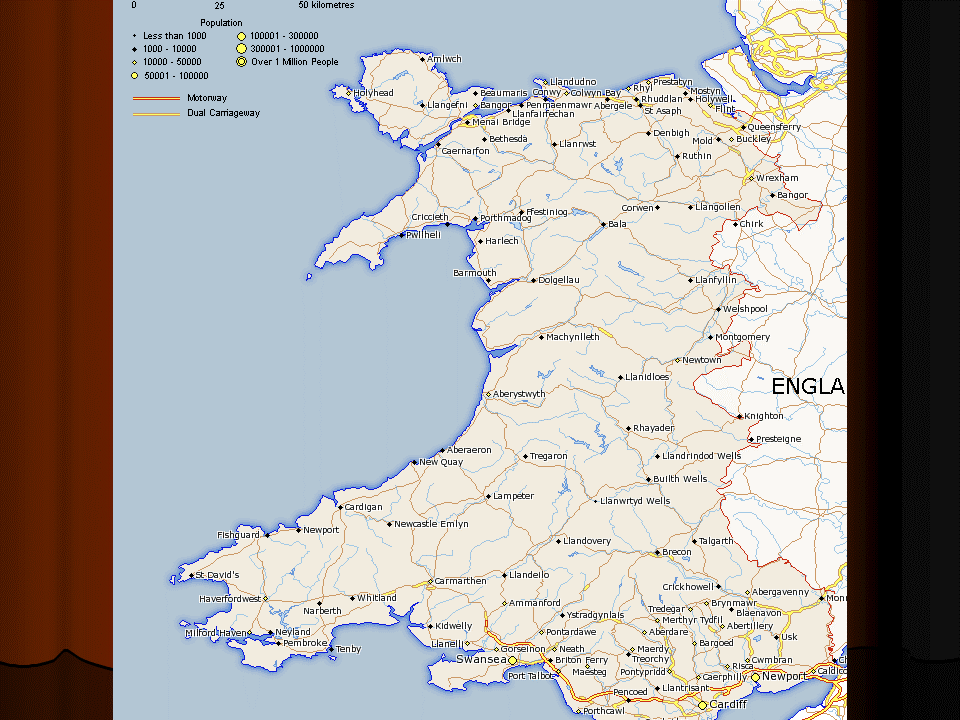
- This map of Wales provides a little clearer idea as to the relative location of four very important towns in South Wales – Merthyr Tydfil, Cardiff, Swansea, and Carmarthen.
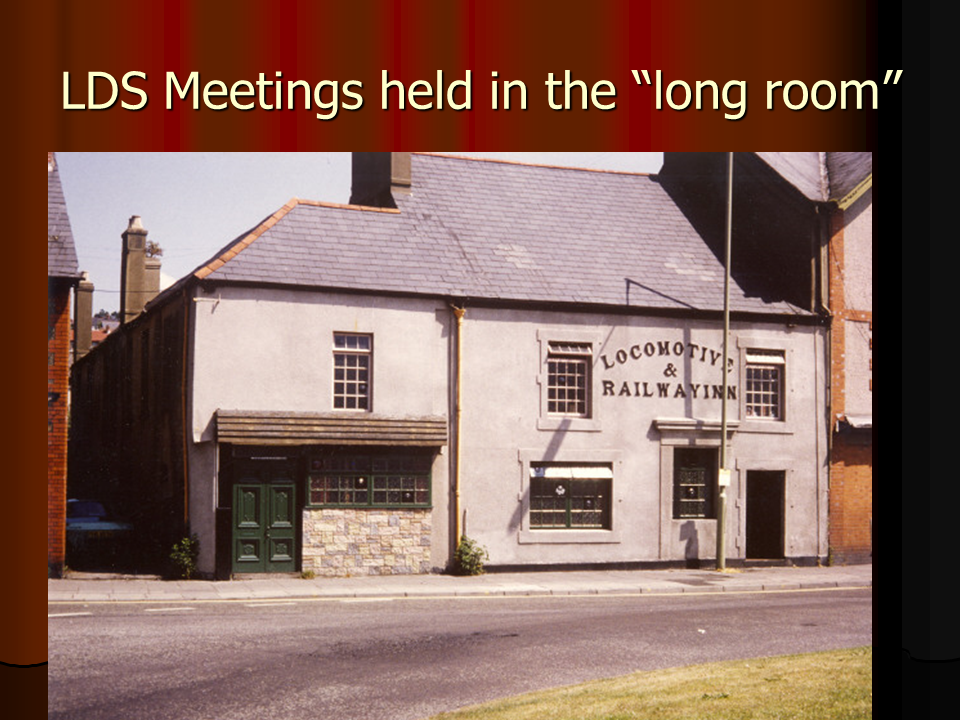
- This is the Locomotive and Railway Inn – a still-standing building in MT about a hundred yards from the parish church dedicated to St. Tydfil the Martyr. The “long room” above the pub was used for many LDS meetings during the 1840s and 1850s

- Here is a row of miners cottages in Georgetown, Merthyr Tydfil. Dan and Jane Jones lived in number 45.
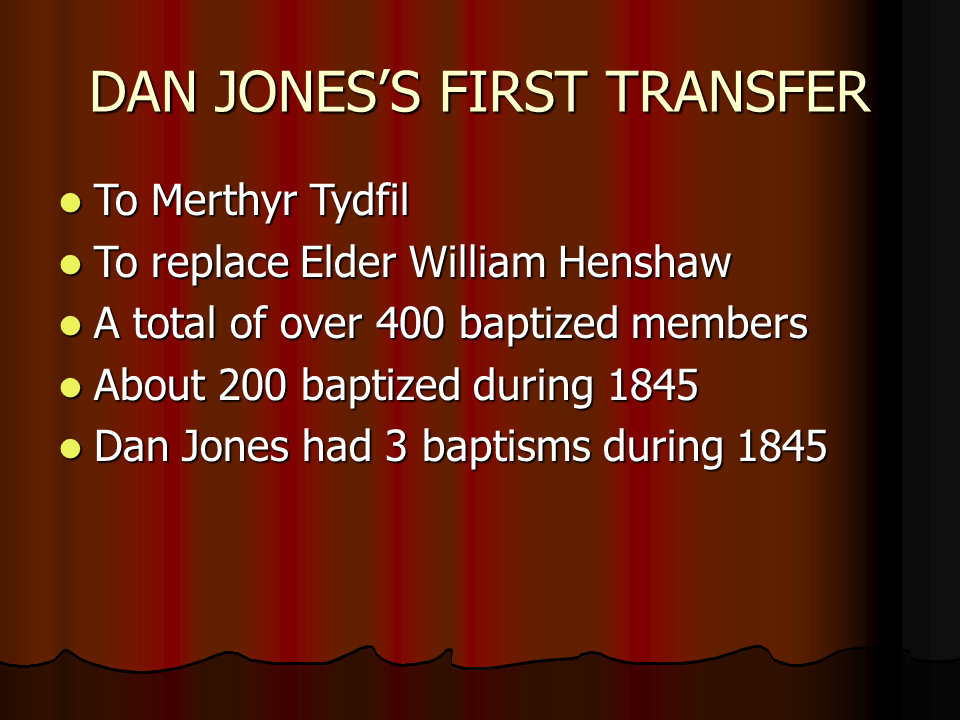
- In mid-December 1845, after nearly a year in North Wales, Dan Jones was transferred to Merthyr Tydfil
- To replace Elder William Henshaw who had been sent there by Lorenzo Snow three years before
- William Henshaw was from Cornwall and spoke no Welsh
- There were a total of over 400 baptized members in and around Merthyr
- About 200 were baptized during 1845
- In contrast Dan Jones, a native speaker of Welsh, had just three baptisms during 1845. I’m sure this comparison had Dan Jones wondering and scratching his head.
- But was it because William Henshaw was a great missionary with three years’ experience and Dan Jones was just a novice?
- I think a lot of it has to do with location.

- The assignment Dan Jones now had in South Wales was to preside over the missionary work in all of Wales.
- Now President Jones had a handful of missionaries who had converted during William Henshaw’s presidency.
- Eleazer Edwards and Abel Evans, still single, were able to serve as fulltime missionaries without purse or scrip. Edwards served a total of 8 years and Evans served a total of 7 years before leaving for America.
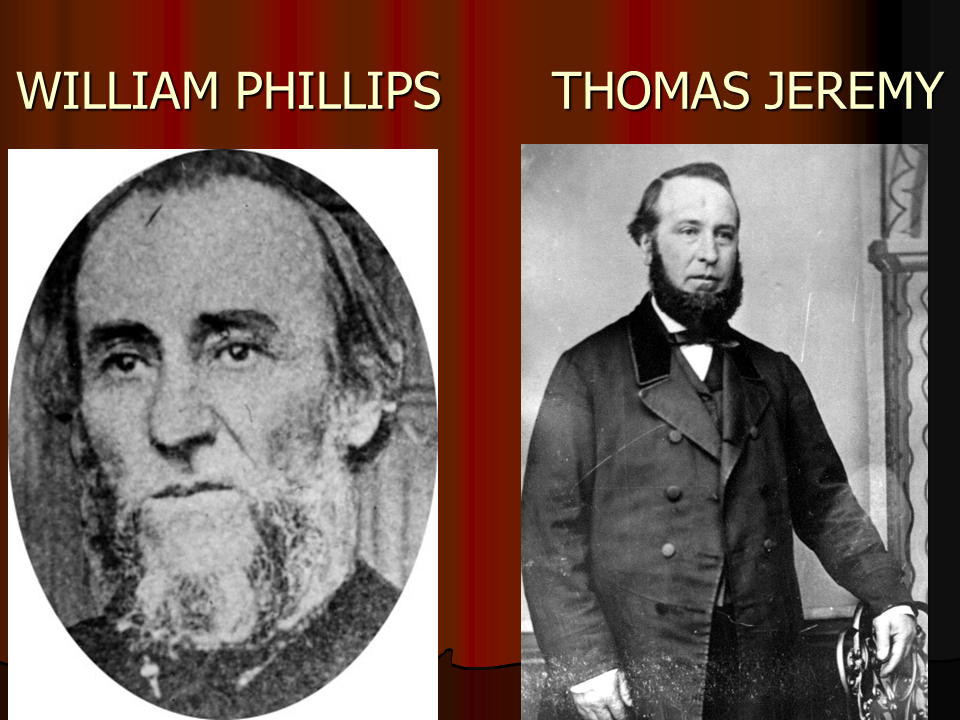
- But most men who “served missions” also had jobs and families to take care of as well. Men like William Phillips and Thomas Jeremy, for example. In three years’ time Phillips would be called to replace Dan Jones. And Thomas Jeremy, a wealthy farmer, would pay the passage of a sizeable number of Welsh converts who were part of the first group of Welsh Mormons to emigrate.

- When Dan Jones arrived in Merthyr Tydfil there were about 400 members of the Church.
- During 1846 there were about 500 convert baptisms, making a total of 900 members of the Church.
- And during 1847 there were nearly 1,000 baptisms, making a total of 1,900 Welsh Mormons.
- 1848 was the most productive year ever in Wales – over 1,700 were baptized, pushing the Church population to over 3,600 at the end of the year when Dan Jones released himself as President of the LDS Church in Wales.
- I say “released himself” because the folks from Liverpool did not show up at the large conference held in Merthyr Tydfil as they had promised. So Dan Jones did the logical thing by releasing himself and setting apart the new presidency.
- It is unclear whether or not he called for a vote of thanks for his service.
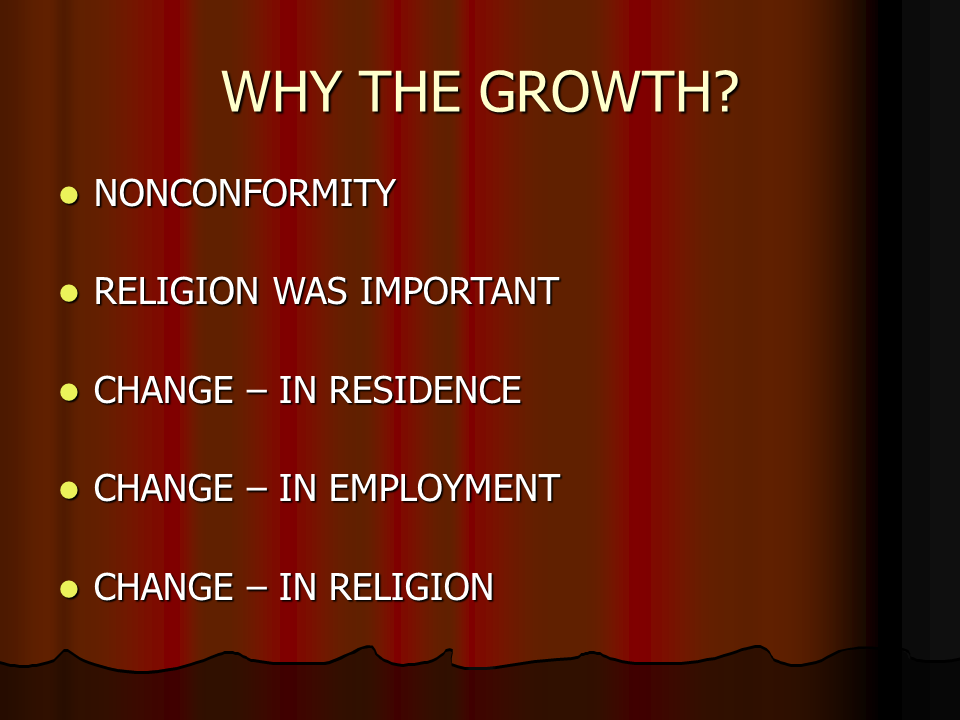
- With such a skeleton crew of missionaries what were the contributing factors to the phenomenal growth of the Church in Wales during 1846, 1847, and 1848? Let’s consider a few possibilities.
- Over the previous several decades the Welsh had become a “Nonconformist” people – Baptists, Methodists, Congregationalists, Unitarians, Independents, etc. There were practically no Catholics. The Welsh didn’t “conform” to the beliefs of the Catholics, nor did they conform to the beliefs of the Church of England.
- A high percentage of these Nonconformists were originally members of the Church of England and eventually they far outnumbered those who stayed with the Church of England
- One of the biggest enemies of growth in the Church today is apathy. Generally speaking, the Welsh were anything but apathetic – religion was important to them.
- The people in Merthyr Tydfil and the surrounding areas were immigrants from other parts of Wales, from England, and even from Europe. They had come for the high paying jobs in the coal mines, the iron mines, and the iron works.
- A farmer from Carmarthenshire who moved to Merthyr Tydfil to work in the iron factory could triple or quadruple his income and live on a much higher level of poverty.
- People who gathered to Merthyr Tydfil, Swansea, and Cardiff made a change their residence and their employment. And they, or their forebears, had also shifted from the Church of England to Nonconformity. Perhaps these changes made them less opposed to yet another change in religion.
- And with an agitator like Dan Jones in this environment putting into action his irrepressible energy, his oratorical skills, and his enormous talent for publishing pamphlets and a periodical, Mormonism would not go unnoticed.
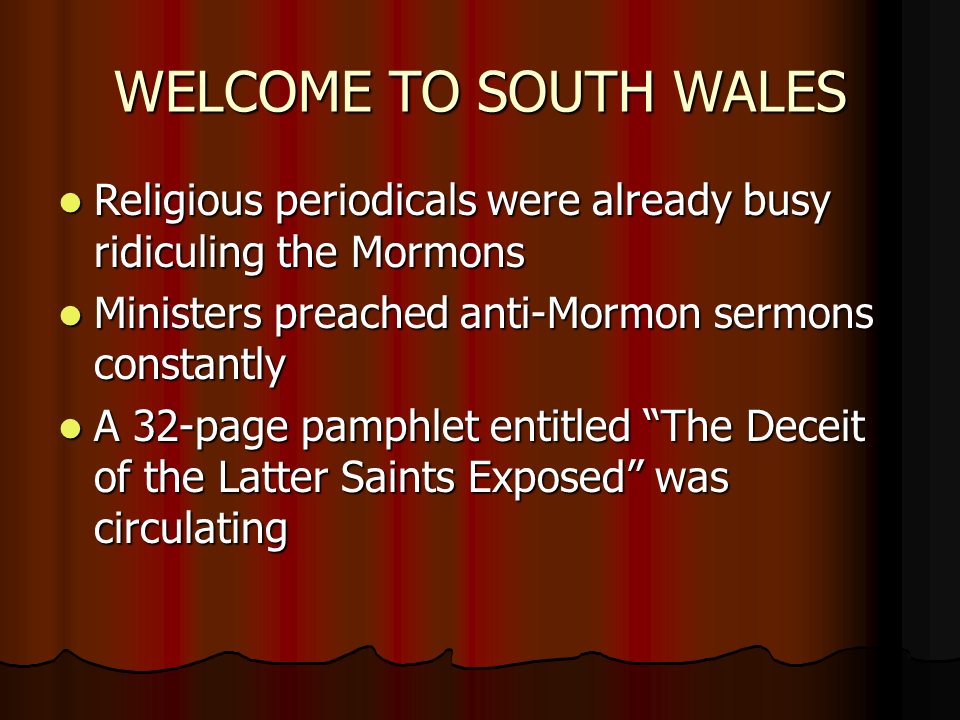
- Welcome to South Wales, President Jones!
- Religious periodicals were already busy attacking the Mormons. William Henshaw was ridiculed for not being able to speak Welsh and also for refusing to take poison to show his belief in miracles.
- Especially active in anti-Mormon preaching and writing was the Baptist minister, the Rev. W. R. Davies, writing under various pseudonyms.
- I don’t know of any rebuttals sent before the arrival of Dan Jones
- Of course, the periodicals refused to publish Dan Jones’s rebuttals, since they were “beneath their attention”
- When Dan Jones arrived in South Wales in December 1845 32-page pamphlet entitled “The Deceit of the Latter Saints Exposed” was circulating. This was the first printed attack on Dan Jones’s pamphlet published nearly nine months earlier.

- Why would rebuttals not be printed? The editor of the Seren Gomer [The Star of Gomer, a Baptist periodical] declared the answer loud and clear:
“It would be a mockery to our nation, an insult against common sense, and stench and slime on the Star [that is, the periodical] to publish [their deceit and their tricks] in its pages. It is abominable to report the things that are discussed by them in their societies; they are a mockery through and through, and a curse and a plague.”

- And what about the 32-page pamphlet “The Deceit of the Latter Saints Exposed” by David Williams?

- Well, Dan Jones fired back with a pamphlet of his own entitled “The Scales in which are seen David weighing Williams, and Williams weighing David; or David Williams, from Abercanaid, contradicting himself, caught in his deceit, and proved deistic” – Y Glorian, yn yr hwn y gwelir David yn pwyso Williams, a Williams yn pwyso David; neu David Williams, o Abercanaid, yn gwrthddweyd ei hun, wedi ei ddal yn ei ddwyll a’i brofi yn ddeistaidd.
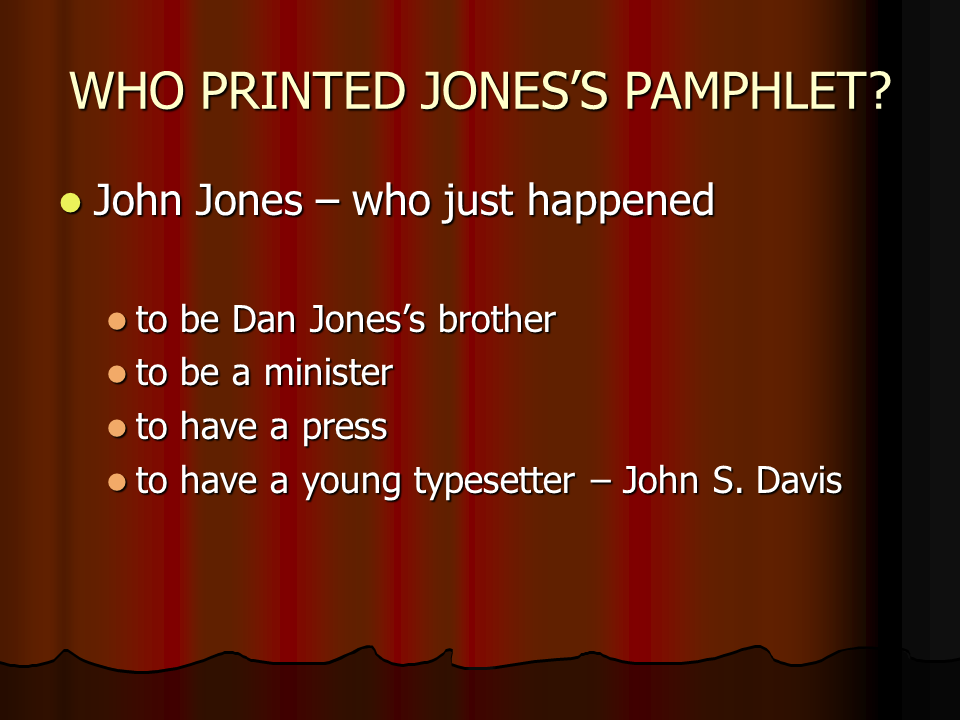
- Who printed Dan Jones’s pamphlet?
- John Jones – who just happened to be Dan Jones’s brother, older by 9 years, and an ordained Congregationalist minister.
- John Jones just happened to have a press at a place called Rhydybont near Llanybydder (a market town located about 50 miles to the west of Merthyr Tydfil. One of his colleagues of the cloth dubbed John Jones’s press “the prostitute press” because it printed Mormon materials.
- John Jones just happened to have a young typesetter by the name of John S. Davis.
- John Jones didn’t ever convert to Mormonism.
- John S. Davis, however, did convert after setting the type for 3 pamphlets.
- Also John Jones’s wife and two daughters were baptized.
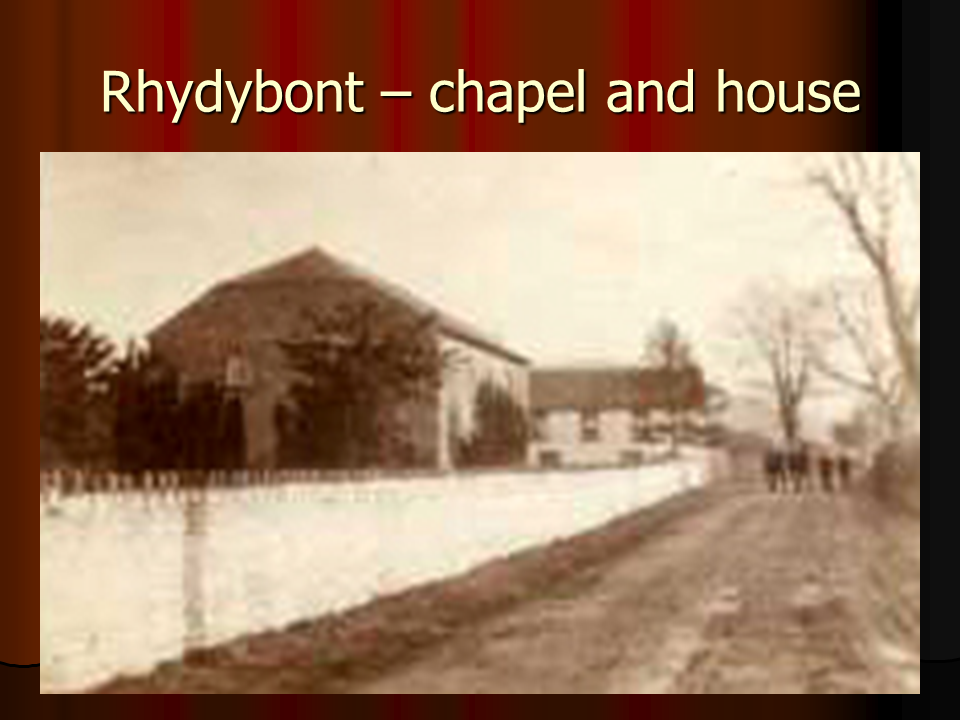
- Here is a very fuzzy picture of the Rhydybont chapel and the minister’s residence – John Jones most likely had his press in his house
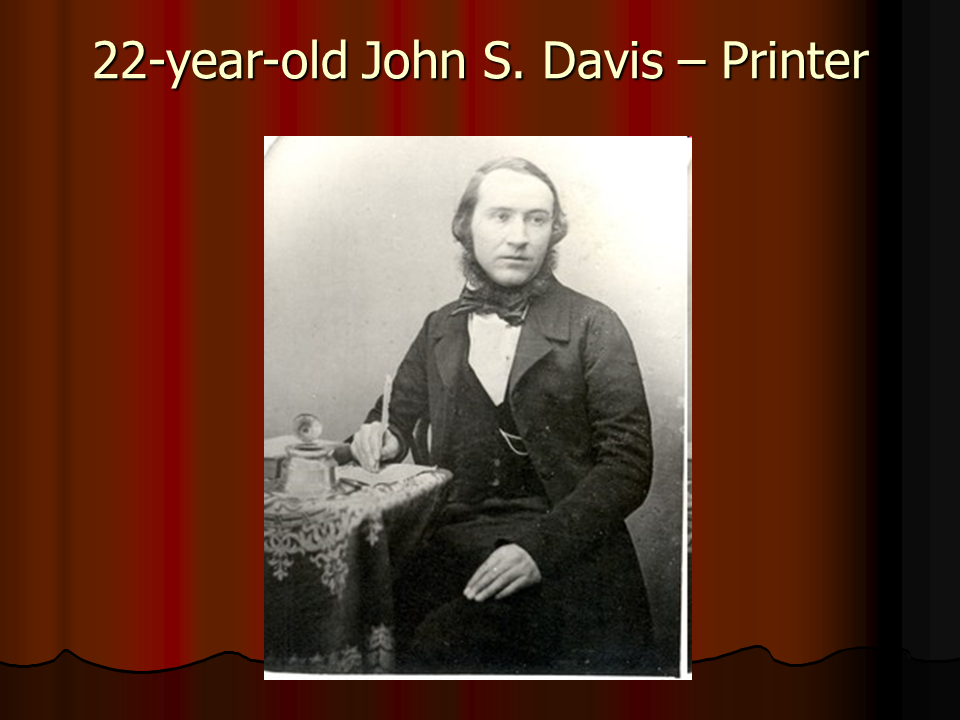
- 22-year-old John Davis was absolutely amazing – not only did he set the type for Dan Jones’s publications – he also became the printer for the Church in Wales when Dan Jones left in 1849. He is the one who translated and published the Doctrine and Covenants, the Book of Mormon, and the Pearl of Great Price in an 18-month period.
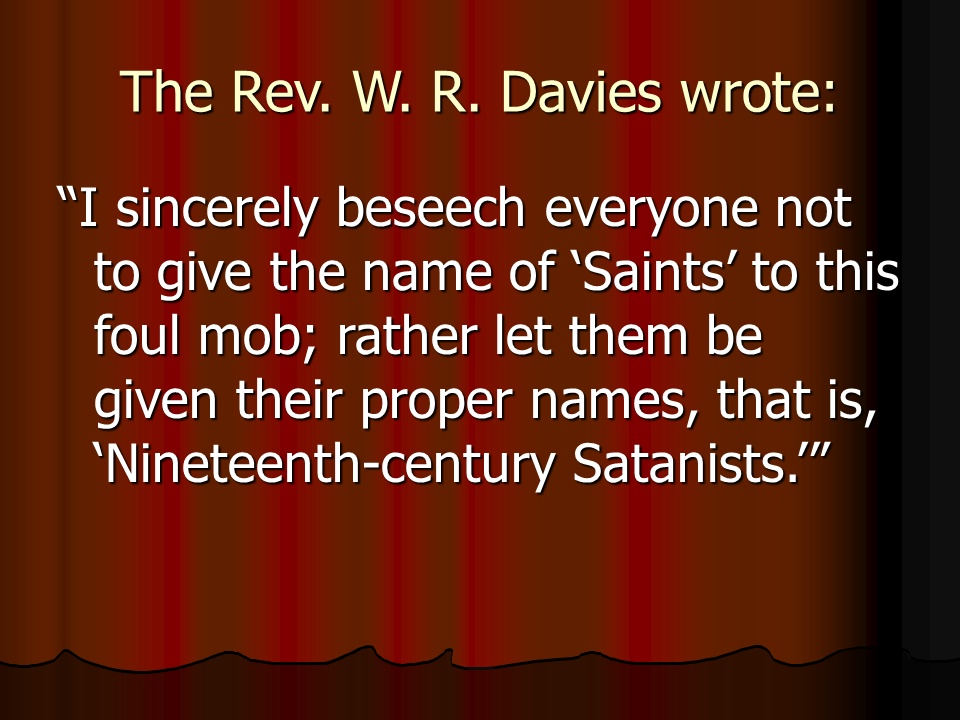
- The Rev. W. R. Davies was a Baptist minister in the Merthyr Tydfil area. Here is a small sample of his contempt for the Mormons who had dared to baptize some of his parishioners, one of them his “right-hand man.” “I sincerely beseech everyone not to give the name of ‘Saints’ to this foul mob; rather let them be given their proper names, that is, ‘Nineteenth-century Satanists.’”

- We see here a list of Anti-Mormon writings of the Rev. W. R. Davies. These are all articles in Nonconformist periodicals except for a 20-page pamphlet.
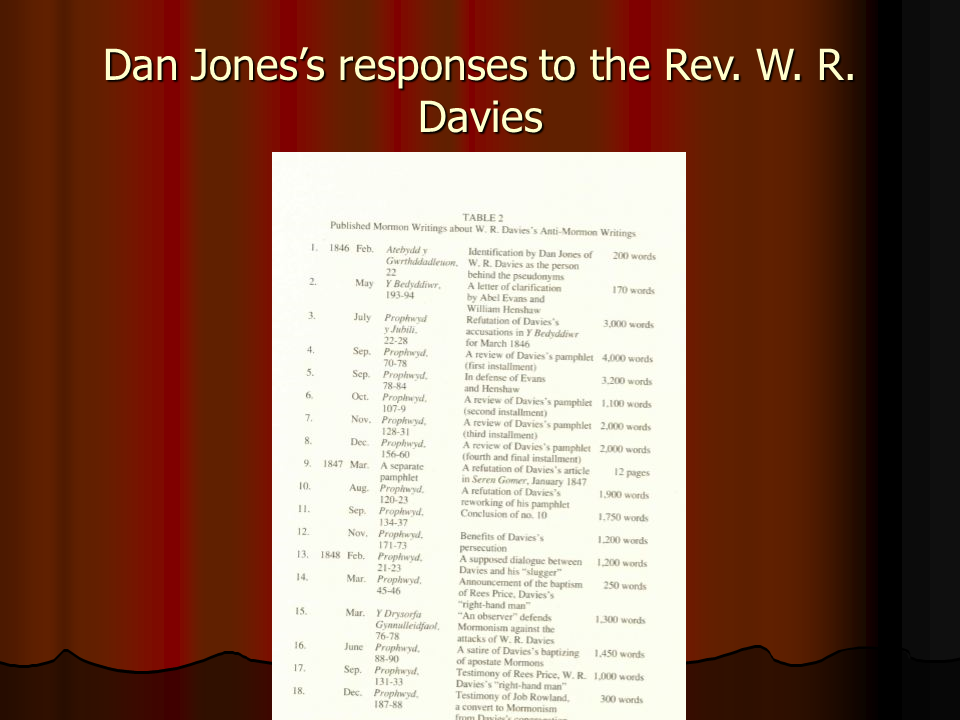
- Of course Dan Jones responded with a list of his own – and there is a story behind each one of these responses.
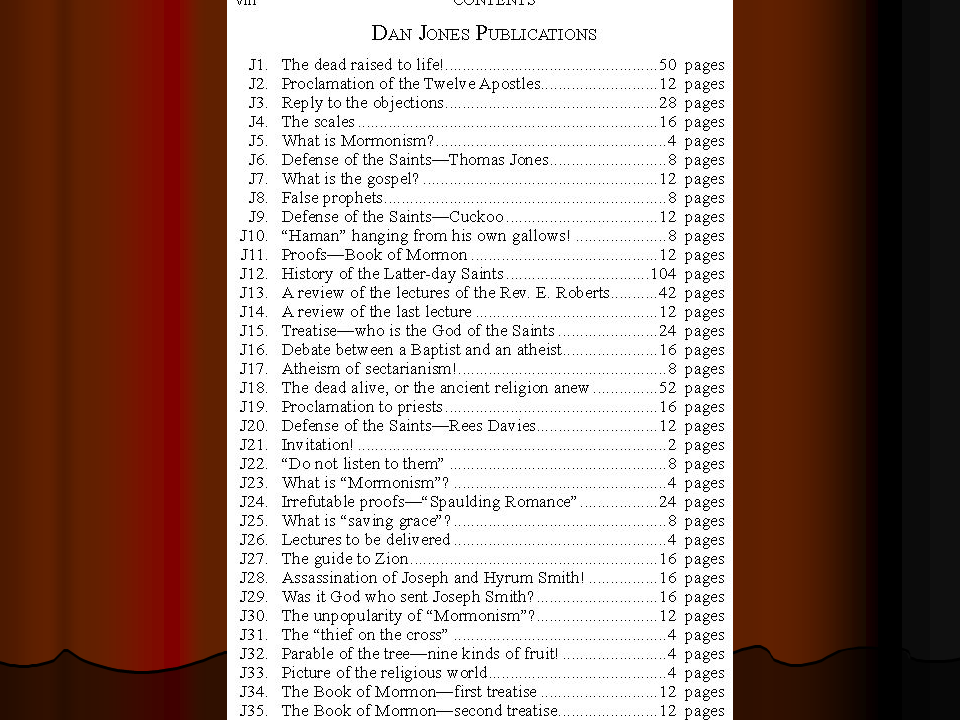
- And this list represents all the pamphlets that Dan Jones wrote and published during his two missions.

- Remember that just before the Martyrdom, Joseph Smith said he had $1,100 for Dan Jones as soon as he could get the check cashed so Dan could be “prepared to buy a Press” – so obviously he had plans to publish things in Welsh in defense of the Church in Wales.

- It’s not clear whether he intended to have his own periodical, but by the time he had been in Wales for a year-and-a-half he had published volume 1, number 1 of Prophwyd y Jubili (Prophet of the Jubilee) on his brother’s press.
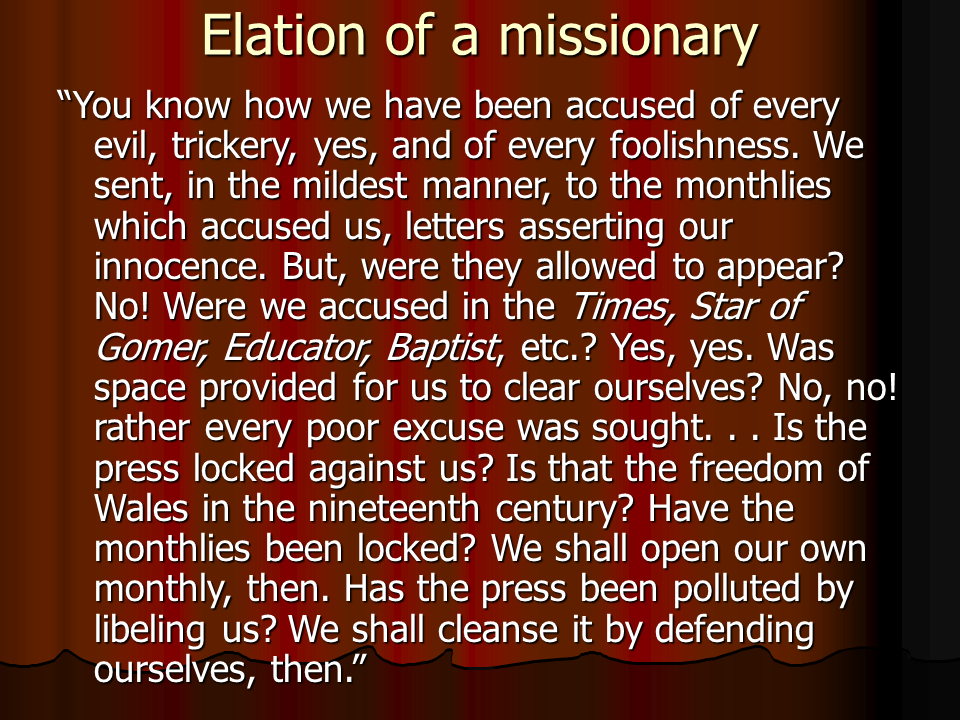
- Elation of a missionary – in the first issue of Prophet of the Jubilee (July 1846) Dan Jones wrote to the subscribers: “You know how we have been accused of every evil, trickery, yes, and of every foolishness. We sent, in the mildest manner, to the monthlies which accused us, letters asserting our innocence. But, were they allowed to appear? No! Were we accused in the Times, Star of Gomer, Educator, Baptist, etc.? Yes, yes. Was space provided for us to clear ourselves? No, no! rather every poor excuse was sought. . . Is the press locked against us? Is that the freedom of Wales in the nineteenth century? Have the monthlies been locked? We shall open our own monthly, then. Has the press been polluted by libeling us? We shall cleanse it by defending ourselves, then.”
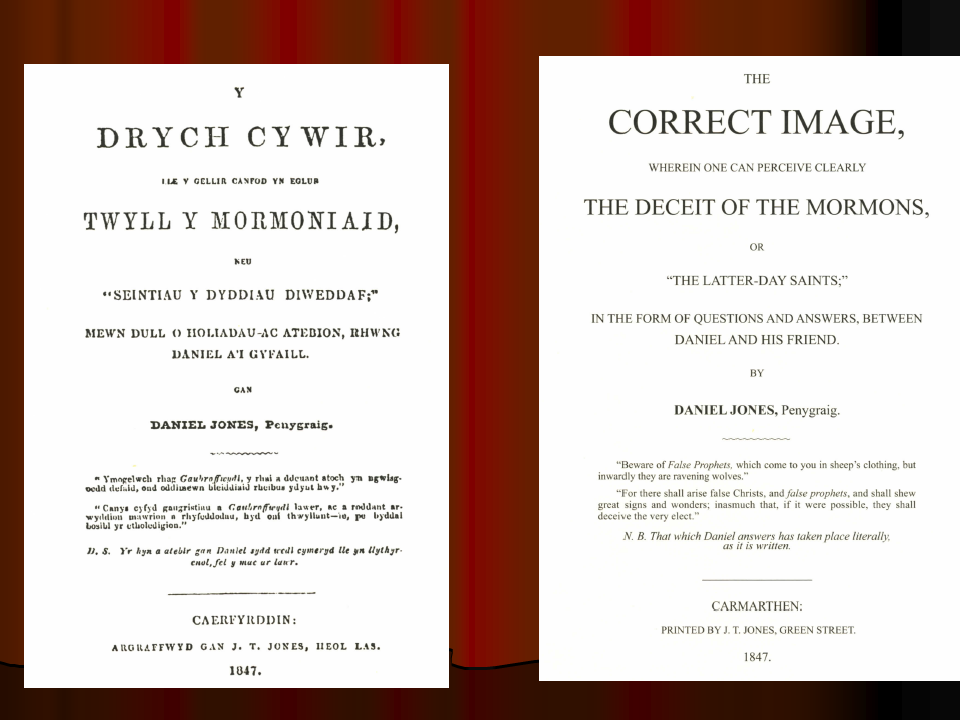
- A blind man by the name of Daniel Jones was baptized in 1846. His plan (with the help of Josiah Thomas Jones, a Congregationalist minister and editor of the periodical The Congregationalist Treasury) was for him to get baptized and then request a blessing to have his sight restored and then tell the world the Church was false because it failed to give him his sight. But during the blessing he exclaimed, “Tis enough, I can see the candle in the candlestick on the table.” Later he denied having said that, and a minister helped him to write a pamphlet entitled, “The Correct Image, wherein one can perceive clearly the Deceit of the Mormons.”
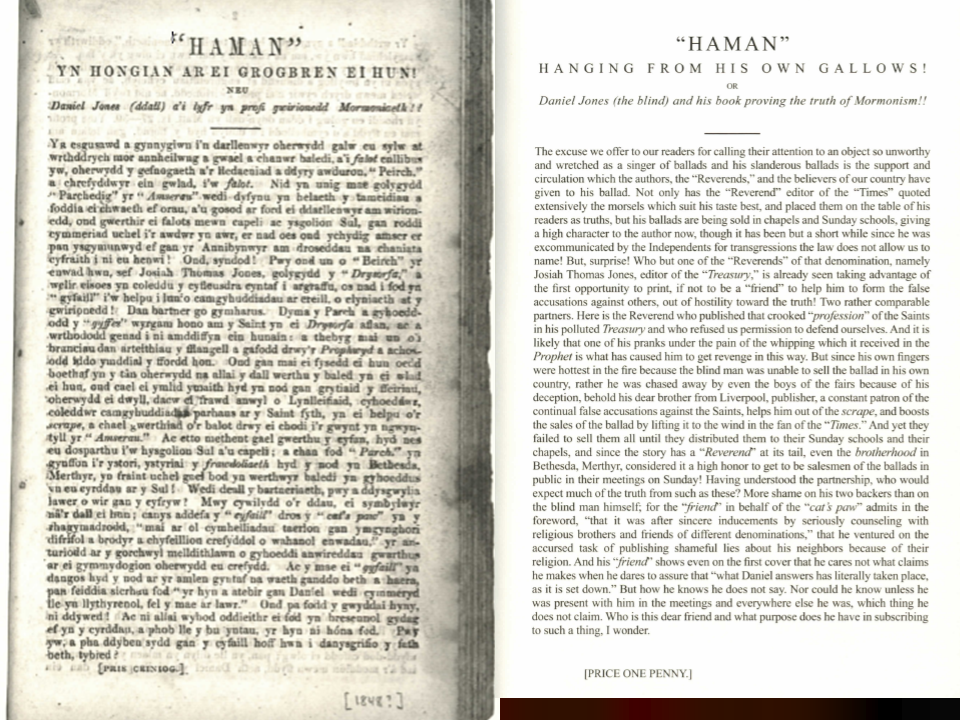
- Dan Jones responded by publishing a pamphlet entitled, “Haman” hanging from his own gallows!”, evoking the image of Haman of the Old Testament who had ordered a gallows built where Mordecai, Esther’s uncle, was to be hanged. But the king eventually ordered Haman and his co-conspirators to be hanged there. The parallel is that the blind man’s attempt to prove Mormonism wrong was foiled, and he was the one “hanged” from the gallows. Several months after the baptism and the blessing Dan Jones told the blind man that if he didn’t stop persecuting the Church his fate would be hotter than that of Kora, Dathan, and Abiram, the three who were swallowed up in the earth after fighting against Moses. Shortly thereafter he contracted an illness that caused him to cry out the he was “burning up alive.” In a letter published in the Millennial Star Dan Jones wrote: His friends poured cold water on him night and day in vain! He would rush out from them to a pool that was by, and there he would roll, and wallow, and help until he terrified the passers by.” Jones commented on the blind man’s death that he “died a monument of the displeasure of a just God for hypocrisy.”
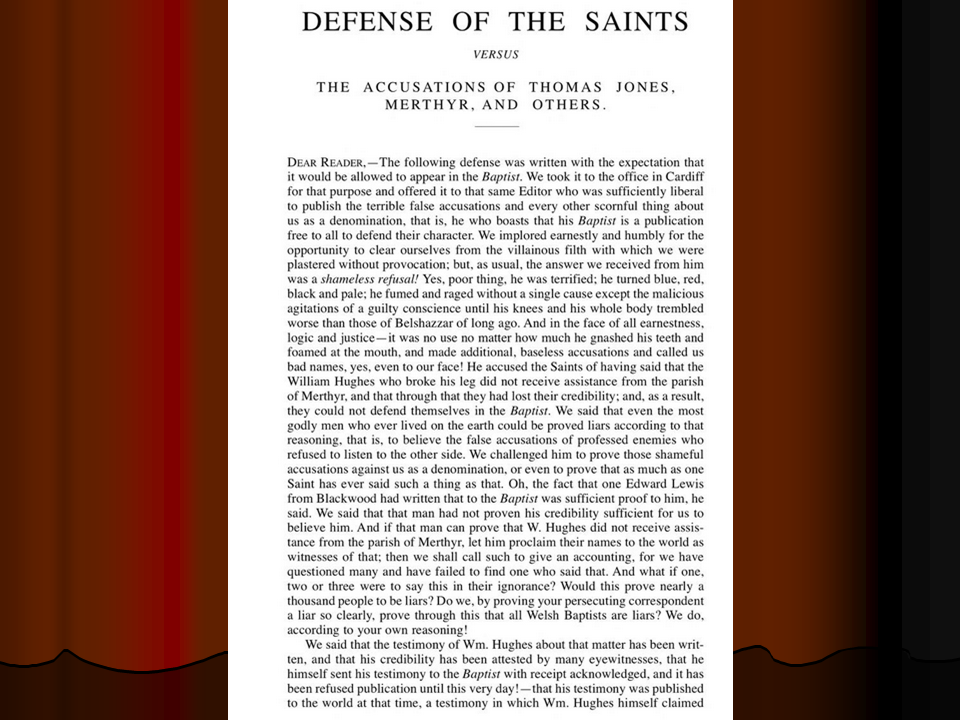
- In 1846 when a convert named Thomas Jones apostatized and invented a story as to how he was hoodwinked by the Mormons, the Baptists were quite happy to publish his story in their periodical. Dan Jones wrote a long rebuttal and went to Cardiff to hand deliver it to the editor of the periodical. Dan Jones describes how he was received by the editor of The Baptist: “We implored earnestly and humbly for the opportunity to clear ourselves from the villainous filth with which we were plastered without provocation; but, as usual, the answer we received from him was a shameless refusal! Yes, poor thing, he was terrified; he turned blue, red, black and pale; he fumed and raged without a single cause except the malicious agitations of a guilty conscience until his knees and his whole body trembled worse than those of Belshazzar of long ago.” A short time later Dan Jones published his rebuttal in an eight-page pamphlet. Here is the title page of that pamphlet.

- Occasionally Dan Jones’s detractors would later become admirers. Here is an example: Thomas John, a 35-year-old single man who was one of the first group of Welsh Mormons to sail to America with Dan Jones in 1849, will serve as an example of an admirer of Dan Jones who left the faith but later wanted to come back into the fold. He was the only one of the Welsh group who disobeyed Brigham Young’s counsel by going to California after gold. Five years later he was back in Wales seeking readmission into the Church. Here is a quote from his letter that was published in the 1854 volume of Zion’s Trumpet: “I am very sorry for having said even one bad thing against you, and I earnestly beg your forgiveness, the forgiveness of the Saints, and the forgiveness of God, so that I can come back to His Church, the only place where there is eternal life.”

- In one of his many attacks on the Mormons the Rev. W. R. Davies recommended that the reader consult the Baptist periodical entitled The Baptist for other witnesses of the untruthfulness of Mormonism. The following is a small part of his response and is one of my favorite bits of Dan Jones’s polemic phraseology: “Is this [referring to the Baptist periodical] not the sinkhole into which you have spewed the contents of your foul insides for years, and would you wish us to sully our noses again in your stinking liquid?”

- In contrast here is one of my favorite segments of his English phraseology contained in a letter to Orson Pratt, 6 January 1849: “Dear President Pratt—After a fortnight’s constant pressure of business, which beset my little barque like a raging tornado, I at length find time enough to report that I am still afloat and seaworthy, with my colors nailed to the mast head.”
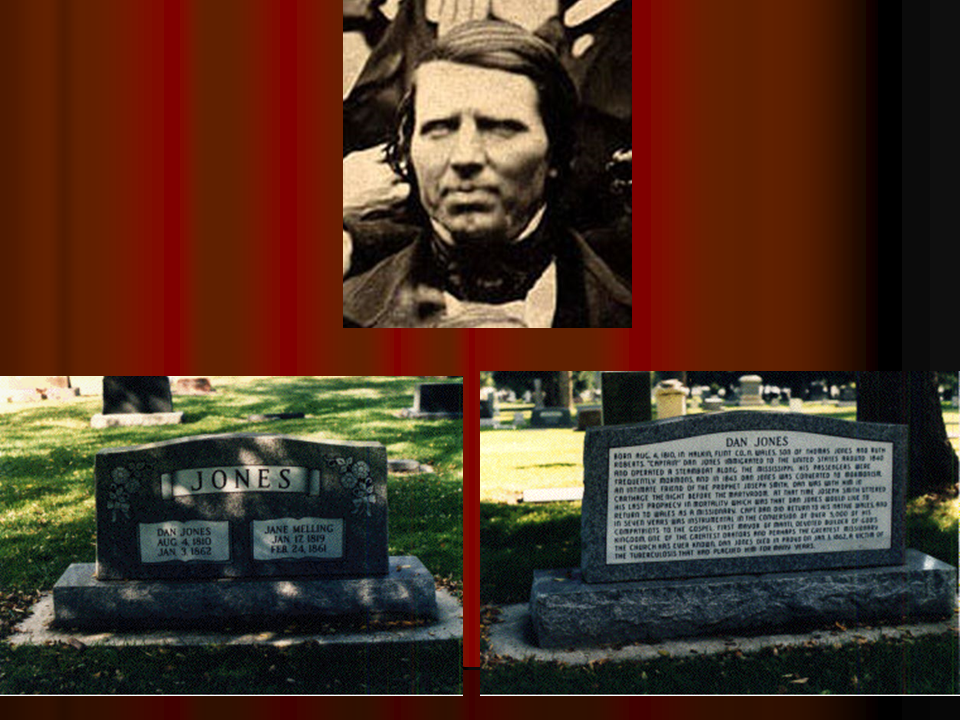
- Dan Jones died at age 51 and is buried in the Provo City Cemetery.
I have given only a woefully incomplete and fragmented portrait of the missionary Dan Jones. But further information can be obtained in the English translations of over 2,000 pages of his writings that are now available – Prophet of the Jubilee, his pamphlets in Defending the Faith, and the various volumes of Zion’s Trumpet, especially the latest volume to be translated – the one for 1854.
I gather from his writings that Dan Jones was a very feisty and even pugnacious person. His conversion to Mormonism, however, was solid – apparently he never wavered. He never received the money for The Maid of Iowa, but he went on his mission and served with distinction. The leaders from Liverpool did not show up for his final conference in Merthyr Tydfil as promised, but he simply released himself and set apart his successor and counselors. He brought a group of 330 Welsh Mormon converts to America. Twenty percent of them died of cholera. 82 of the group continued straight to SLC. All but two voted for Dan Jones’s suggestion that they set up a separate Welsh – but still Mormon – kingdom west of Salt Lake City with Elizabeth Lewis as queen. (You can see my website for the full story.) George A. Smith talked him out of the idea, and Dan Jones later became the first mayor of Utah. He returned to Wales in 1852 to serve a second mission and was again highly successful in gaining an additional 2,000 converts. Some people in Wales and in Utah accused him of some very serious wrong doing. After hearing Jones’s side of the story his leaders gave him their support, and he refused to let such things shake his belief in Mormonism. His testimony was rock solid. Thousands of Welsh converts and their descendants are glad he remained “afloat and seaworthy” with his “colors nailed to the mast head.”
Thank you for your attention.
Q&A
Question 1: Did Dan Jones have any connection to Welsh converts who became members of The Mormon Tabernacle Choir?
Answer 1: Yes, we did a documentary on the choir a number of years ago on BBC, and we asked all the members of the choir who had Welsh ancestry to raise their hand, and three-fourths raised their hands “Yes”. The first conductor of what became The Tabernacle Choir was John Perry, that was in the 1849 group, and it was the nucleus of the small group of 82 LDS, half of those were children. So you had a small group that became members of the choir. [It was] very awkward because they did not know how to sing in English, and the Americans who were part of the choir did not know Welsh. I don’t know how he worked it out, but somehow he did, and we have today the Tabernacle Choir.
Question 2: Prior to the translation into Welsh of The Book of Mormon, did it play any role in missionary work?
Answer 2: It did but people couldn’t read it, because it was in English. But, yes, it did play a role. They had copies and they would talk about it and use it as a missionary tool.
Question 3: In a nutshell, what is the significance of Benbow Farm?
Answer 3: Yes, Benbow Farm has a nice plaque where Wilford Woodruff spent a good part of a couple of days clearing away everything so he could do his baptisms. He reports that he baptized all but one of 600 members of the United Brethren at Benbow Farm which is over in Hertfordshire not too far away from the border of Wales.
Question 4: Was Dan Jones ever called to early leadership in the Church? Why or why not?
Answer 4: No. Because he was called on a mission and that’s what he wanted to do and what Joseph Smith wanted him to do. He was a leader over there but not back here. All of those leadership roles were pretty well filled up.
Question 5: Did Dan Jones answer or respond to negativity in regards to polygamy?
Answer 5: No, but he himself had three wives; two children by each that survived. Yes, he supported that. It was hard for him to in 1853–that’s when it broke. He had a series of articles in the magazine, explaining the Mormon position on polygamy.
Question 6: Is the pollster Dan Jones a descendent of this Dan Jones?
Answer 6: Negative, it’s just coincidence. As I said before, the Welsh have no imagination in names. They are all recycled. It is just a coincidence.
Question 7: P’nawn da. (That means “good afternoon”.) Growing up in Wales I can tell you that Wales is a country, not a principality. This is an English myth. [audience laughter]
Answer 7: It is all how you cut it.
Question 8: Dan Jones. How did he die?
Answer 8: He died of lung disease caused, I think, from working in the lead mines. He complained about that over the years.
Question 9: His posterity?
Answer 9: Not like some. He just had two children by each wife, six children, and probably a modest number of descendants.
Question 10: What seems to be the central accusation of the Welsh against the Mormons?
Answer 10: Miracles was a focal point. They claimed to work miracles. William Hughs received a blessing and his leg got better, the doctor was amazed, that sort of thing.
“No, no that did not happen!” then go back and forth. That was one of the main things was healing; and also miracles and angels and things like that. Just the common stuff that we’ve all heard about.
I do have a small anecdote. May I tell this anecdote?
How did the Welsh deal with every name all the same?
The way they did that was to either add a middle initial or they would attach it to what they did, like if you were a hairdresser, why you’d be Jones, the Hair. If you were a butcher it was Jones the Meat.
There is a story told about a person who worked for the CIA, who was to be dropped into Wales and to find somebody named Jones and the code was “The daisies bloom in the spring.”
He was dropped into Wales, took off the parachute and folded it up. He saw a man and said, “Are you Jones?”
[Welsh man:] “Yes, I am.”
He [CIA] said, “The daisies bloom in the spring.”
He [Welsh man] thought and said, “Oh, wait a second. If you go into the village, it is the second door to the right. There is where Jones the Spy lives.” [Laughter.]
